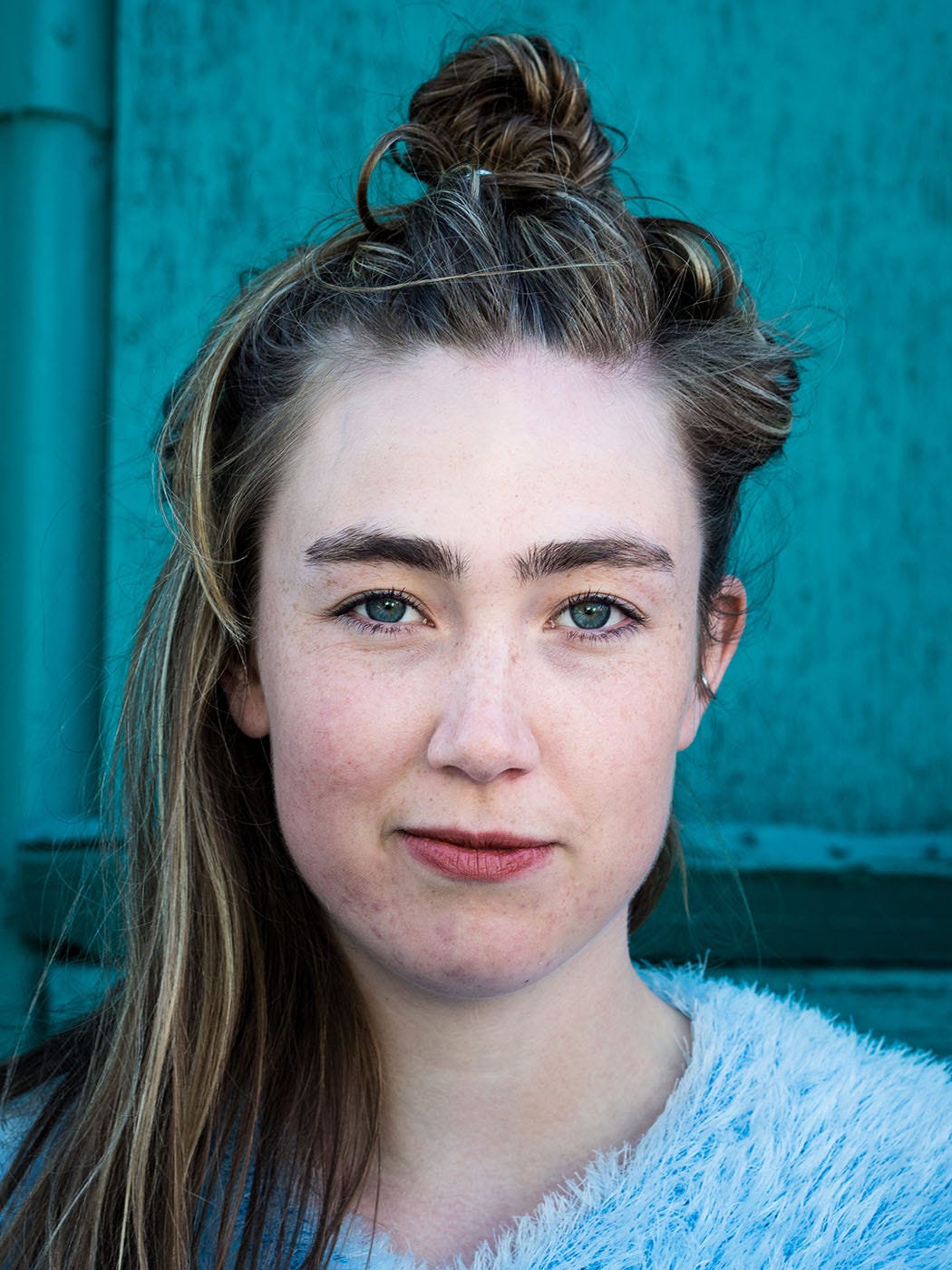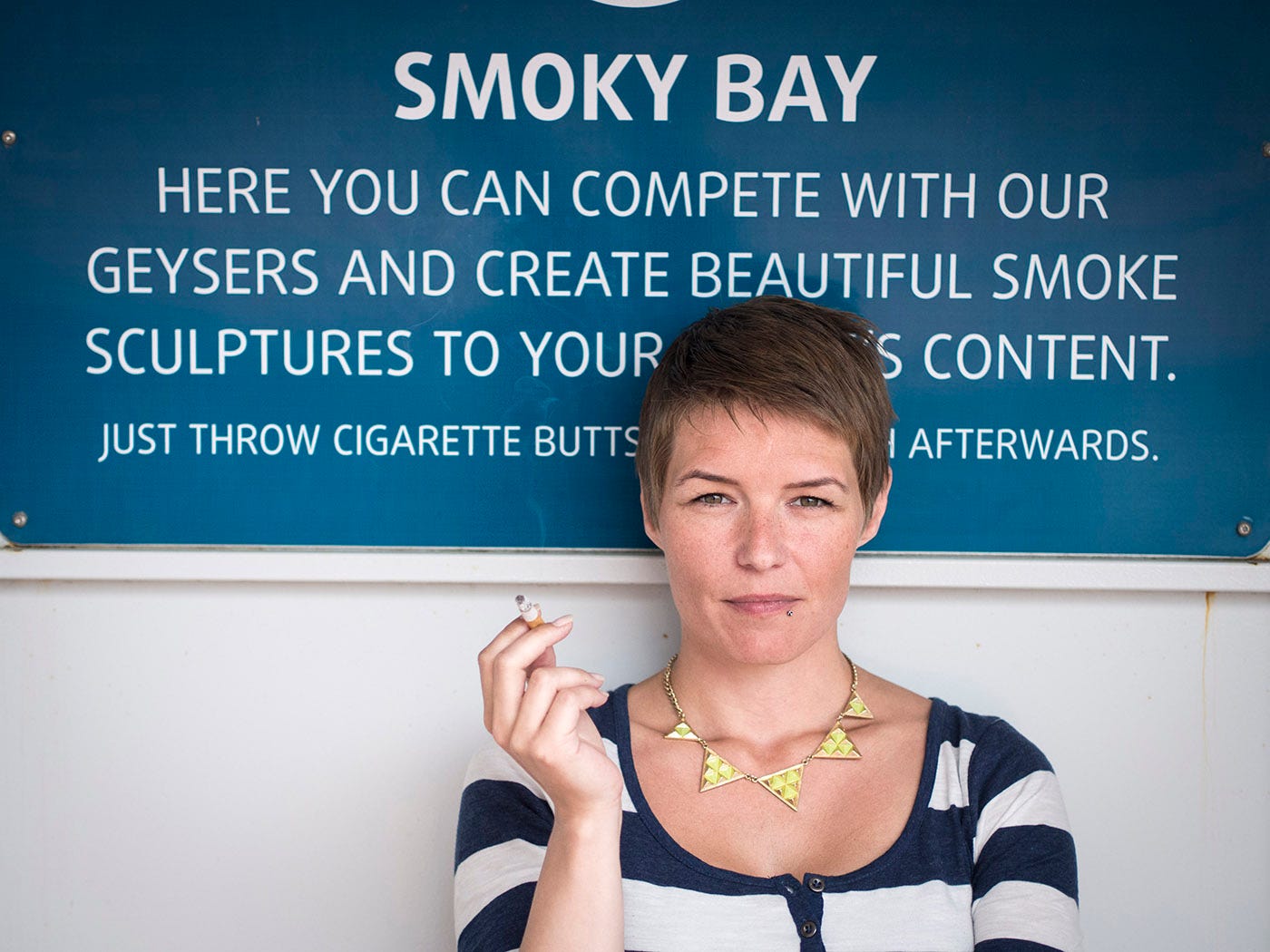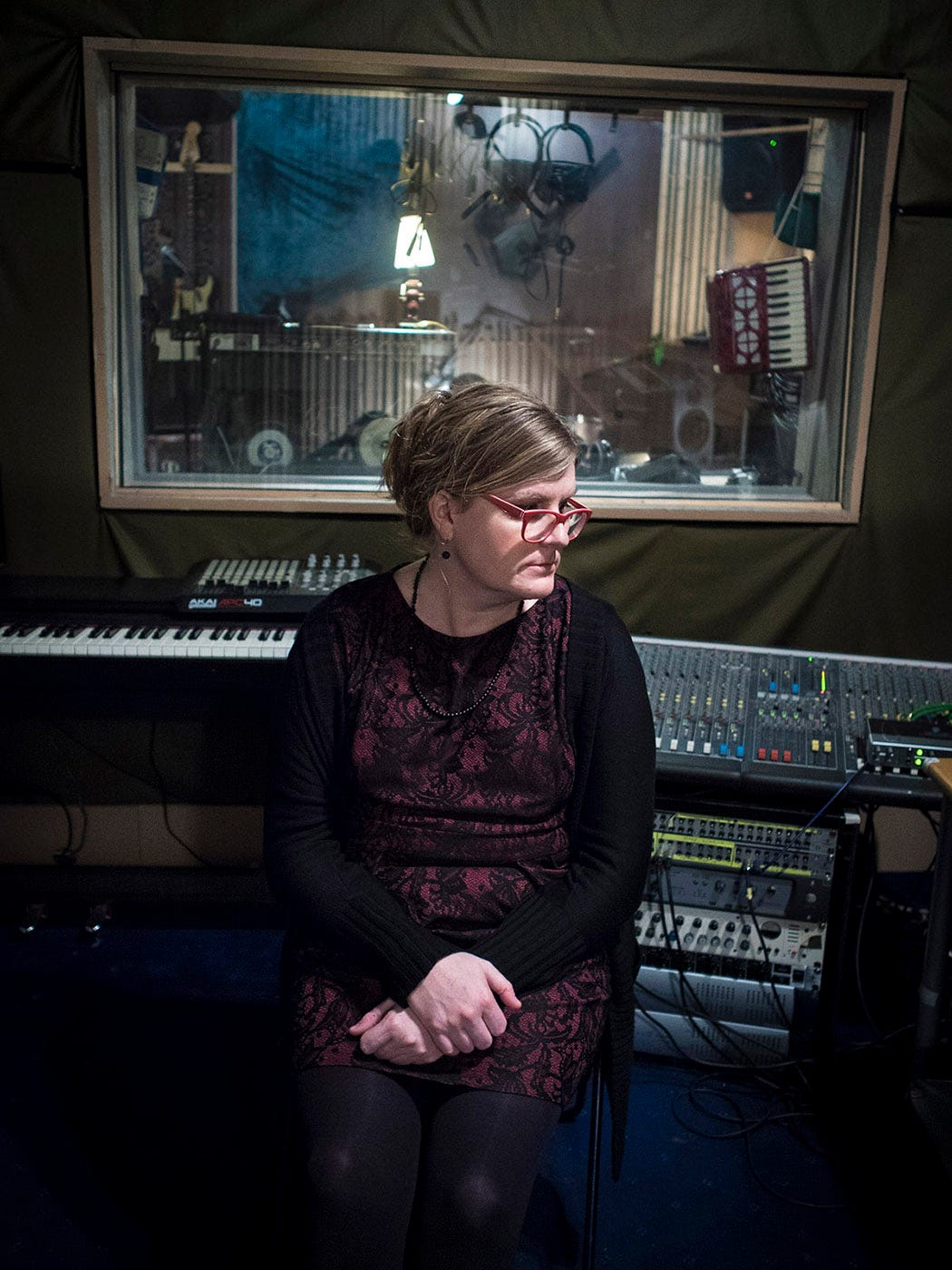Emily von Hoffmann: Your project, “An Equal Difference” explores the individual gender dynamics of a country that, at the aggregate level, has the greatest gender equality in the world. You wrote in your Kickstarter that evidence for this includes Iceland’s “measures like the jailing of bankers responsible for the crash, creating an energy policy based on independent, renewable sources, maintaining a socialized child care system, and making prostitution illegal by criminalizing the buyers instead of sex workers.” So…if possible, can you react with some of the big takeaways from your two years of work? What are some of the broadest conclusions that you were able to make?
Áslaug Rún Magnúsdóttir. Image courtesy of Gabrielle Motola.
Gabrielle Motola: I wouldn’t call those measures ‘evidence’, but it is interesting to consider the relationship they have to gender equality which is largely what I’m exploring in the book. Women alone are not the key to equality. Men and their behaviour have as important a role to play in equality and to discount that because of patriarchy is short sighted and sexist. Despite being the most gender equal society, sexism still exists in Iceland. It is essential to discuss the relationship between sexism and gender equality. This project has inadvertently made me examine my own sexist biases towards both women and men beyond what I have naturally done in my life.
The success we will have with gender equality will largely depend upon our own ability to be aware of ourselves and address issues which are buried deep beneath our skin. Equality is not going to arrive solely from outside measures like gender quotas, which are enforced in Iceland. Quotas are however a necessary part of the solution in the same way affirmative action was. We aren’t evolved enough to be fair entirely of our own accord. True equality comes from a journey begun from the inside out. What follows from this is that there is a functional relationship between gender equality and intelligence for individuals and for the construction and administration of society.
EvH: How aware are individuals of their country’s reputation for gender equality on a day to day basis? Do you think it actively influences behavior, by pressuring people to live up to that standard, for example? Or is it simply built in at this point?
Lív Bergþórsdóttir. Image courtesy of Gabrielle Motola.
GM: I believe many Icelanders are aware of the statistics. However, I do not think it influences their behaviour. Lív Bergþórsdóttir, the CEO of one of Iceland’s largest telecom companies pointed out to me that Icelandic women are no different than any other women in the world. They just have more societal structures, like socialised child care, which allow them to have families while educating themselves, or while having their careers. The inference is that anyone given that structure would thrive equally. The balance of life is better and people act accordingly. I’m certain this applies to men too. They have more rights to paternity leave than their counterparts in the USA and according to the law there is joint custody of children at divorce and end of cohabitation unless otherwise agreed. The interpretation however is still felt to be biased in favour of women, something which needs examination as family structures change. I photographed and spoke with Símon Sigvaldason, a Reykajvík district court judge who deals with child custody among other social issues to find out how things are on the ground rather than in the law books.
EvH: I wonder if in your portrait sessions, women ever discussed their own experiences with sexism at all? In the U.S. for instance, I think the bulk of one’s energy goes to simply explaining why some comment was misogynistic. As an American woman, I always imagine that process as being so much easier in a place like Iceland, since it is always held up as a model of equality. Was there any wisdom shared on that topic?
GM: Women experience sexism in Iceland as they do in other countries but perhaps it’s not as prevalent. Women discussed their experiences with sexism in all its various guises, including rape and abuse but also the subtler and more insidious forms of sexism. It is important to remember that equality doesn’t exist anywhere yet. There is still a gender pay gap in Iceland as there is elsewhere. People are better behaved in Iceland as a whole but that doesn’t illuminate anything about what goes on inside their heads. I spoke a lot about this to Hildur Lilliendahl who became known in Iceland through pointing out misogynistic comments in public forums on the internet by collecting them on a tumblr blog which is now closed. She received lurid abuse for her posts which mostly involved nothing more than re-posting verbatim what had been written publicly.
Hildur Lilliendahl Viggósdóttir. Image courtesy of Gabrielle Motola.
Watch dogs are important but it makes you a target. The less support there is for watch dogs the harder it is to stand ground. What we are often missing in situations is support to point out sexist behavior and address it immediately. This is a role for which men are just as well suited as women. I understand that just like anywhere else, men witness misogynistic behavior, especially in the workplace, but say nothing about it due to social dynamics and pressures. That said, misandry is no less shameful and should not be tolerated but perhaps people feel more justified in it given the way the world is tipped? I don’t find solace in either. Wars end with the signing of peace treaties and the maintenance of good behavior.
EvH: Towards the end of your project, you decided to include portraits of men. Can you please walk us through that creative decision? How did that change your process and the project as a whole?
GM: I initially set out to explore the balance women bring to the decisions a culture makes. I didn’t actually find out about the gender equality statistics until I had been to Iceland for the second or third time. If you think about it, most decisions in our cultures have been made almost entirely by men, and a certain subset of men at that. That’s less than one half of a population deciding what’s best for the entire society. I’d dare to call that taxation without representation. An example of this is the tampon tax in the UK. Women’s sanitary products are classed as ‘luxury non-essential items’. The decision to include men wasn’t a creative decision so much as it was an ethical one. How can one discuss equality without men? I wanted to do this without patronizing men and without overshadowing the discrimination women face. It took time to discuss this openly with several men and women. After about a year I naturally came to a point where I felt confident I could do this. I have had to and still am examining my own biases. The way in which I interface with men is different than women. I have more fear and less confidence which is not surprising but rather frustrating. This has been somewhat uncomfortable to confront. But above all it presents an interesting opportunity to change once I allowed myself to admit and confront the reasons. They are almost always rooted in biases. But I feel that I am a more balanced human being as a result of this exploration and I have more compassion not only for myself but for others. I do think this has helped my creativity too. I’m looking under some seemingly unmovable rocks.
Símon Sigvaldason. Image courtesy of Gabrielle Motola.
EvH: How did the process of making this project and meeting all of these people cause you to reexamine your own understanding of gender? How are you different now?
GM: My understanding of gender has been both clarified and fortified by this project. Gender is an identity we are given or assume based on an antiquated societal structure which is then reinforced by that society. It is an idea which we take for fact. I suppose I have always felt somewhat awkward in my female gender because I identify with so many ‘male’ characteristics. I feel more comfortable now than before and embrace more wholly both sides without suspicion. The discussions I’ve had with Alison MacNeil have informed a lot of what I thought I knew about gender and identity. She is a transgender singer and guitarist working in tech. We have discussed her experience of people’s behavior towards her before, during, and after her male to female transition. You might be able to imagine the differences, but it was fascinating and frustrating to hear it from her directly. She told me that, post-transition, trust was no longer implicit: people worried more about the decisions she would make for herself, jobs and other opportunities did not come as easily as before, and it became more difficult to be heard in group discussions.
We have these fixed ideas about what we should be like or what we should expect from others based on their biological endowments. We are discouraged if not within our families, in society from expressing characteristics which are incongruous with what society perceives our ‘rightly oriented’ gender identity to be. Even if we experience certain characteristics to be untrue for us, their expression is reinforced and rewarded by society. This is tempting. Many of us go so far as to repress these ‘conflicting’ characteristics which are in conflict with how one is ‘supposed to be’. Say for example a nurturing, quiet male who dislikes sports and prefers making things and enjoys discussing emotion. Human beings are more complicated than the current binary allows support for. I believe the repression of socially incongruous yet naturally occurring characteristics in oneself is the root of both misogyny and misandry.
Katrín Jacobsdóttir. Image courtesy of Gabrielle Motola.
EvH: Can you please tell us about one or two of your favorite images from the project, and the situation surrounding them?
GM: I know this is incredibly semantic but I am not a fan of the concept of favorite. I don’t think I am alone there either. My preference changes with time. I can tell you that looking back today as I type this I am favoring the image of Unnur [top] I made in the pool. I didn’t expect it would turn out as it did. She used to model and is very aware of her image. Trying to capture a moment of her unconscious of herself was a challenge. I think I succeeded. What’s more is that it is not a glamour image. You see her strength but you also see a soft and gentle manner which is how she prefers to approach the fulfillment of her dreams.
As for surprises, there were plenty like this and more. All of the shoots had images in them which hadn’t registered, or I had dismissed on the basis that they were not ‘good’ enough. Through the project, in fact thanks to one specific woman in it, I came to realise that ‘good’ largely meant ‘flattering’. I used to photograph women through the gaze we are all trained to look at women with; beauty. The surprising thing was how deeply buried this conditioning was. I confronted this bias and began to deconstruct and let go of my conditioning. I’m not there but I’m on my way. I go into this in the book and show examples of the choices I made before and after the realisation. That’s the incredible thing about awareness. It isn’t there and then suddenly you can not imagine how you didn’t see it before.
Alison MacNeil. Image courtesy of Gabrielle Motola.
Main image: Unnur Valdís Kristjánsdóttir. Image courtesy of Gabrielle Motola.
Interview by Emily von Hoffmann and Polarr
Gabrielle Motola is a London-based photographer. Follow her on Twitter. Support her project, “An Equal Difference.”